Influence of Shaped Hole and Seed Disturbance on the Precision of Bunch Planting with the Double-Hole Rice Vacuum Seed Meter
Abstract
1. Introduction
2. Materials and Methods
2.1. Seed Meter and Test Stand
2.2. Rice Seed
2.3. Measurement of Precision of Bunch Planting
2.4. Statistics and Analysis of Data
3. Effect of the Shaped Hole on the Precision of Bunch Planting
3.1. Shaped Hole
3.2. Results and Analyses
4. Effect of the Seed Disturbance Structure on the Precision of Bunch Planting
4.1. Seed Disturbance Structure
4.2. Results and Analyses
4.3. Multiple Regression Models
4.4. Discrete Element Simulation
5. Discussion
6. Conclusions
Author Contributions
Funding
Data Availability Statement
Conflicts of Interest
References
- Zhang, M.; Wang, Z.; Luo, X.; Zang, Y.; Yang, W.; Xing, H.; Wang, B.; Dai, Y. Review of precision rice hill-drop drilling technology and machine for paddy. Int. J. Agric. Biol. Eng. 2018, 11, 1–11. [Google Scholar] [CrossRef]
- Tao, Y.; Chen, Q.; Peng, S.; Wang, W.; Nie, L. Lower global warming potential and higher yield of wet direct-seeded rice in Central China. Agron. Sustain. Dev. 2016, 36, 24. [Google Scholar] [CrossRef]
- Li, H.; Zhao, C.; Yan, B.; Ling, L.; Meng, Z. Design and Verification of the Variable Capacity Roller-Wheel Precision Rice Direct Seed-Metering Device. Agronomy 2022, 12, 1798. [Google Scholar] [CrossRef]
- Li, H.; Zeng, S.; Luo, X.; Fang, L.; Liang, Z.; Yang, W. Design, DEM Simulation, and Field Experiments of a Novel Precision Seeder for Dry Direct-Seeded Rice with Film Mulching. Agriculture 2021, 11, 378. [Google Scholar] [CrossRef]
- Liu, H.; Hussain, S.; Zheng, M.; Peng, S.; Huang, J.; Cui, K.; Nie, L. Dry direct-seeded rice as an alternative to transplanted-flooded rice in Central China. Agron. Sustain. Dev. 2015, 35, 285–294. [Google Scholar] [CrossRef]
- Guo, J.; Yang, Y.; Memon, M.S.; Tan, C.; Wang, L.; Tang, P. Design and simulation for seeding performance of high-speed inclined corn metering device based on discrete element method (DEM). Sci. Rep. 2022, 12, 19415. [Google Scholar]
- Wang, B.; Na, Y.; Liu, J.; Wang, Z. Design and evaluation of vacuum central drum seed metering device. Appl. Sci. 2022, 12, 2159. [Google Scholar] [CrossRef]
- Xing, H.; Wang, Z.; Luo, X.; He, S.; Zang, Y. Mechanism modeling and experimental analysis of seed throwing with rice pneumatic seed metering device with adjustable seeding rate. Comput. Electron. Agric. 2021, 188, 105697. [Google Scholar] [CrossRef]
- Tang, H.; Guan, T.; Xu, F.; Xu, C.; Wang, J. Test on adsorption posture and seeding performance of the high-speed precision dual-chamber maize metering device based on the seed characteristics. Comput. Electron. Agric. 2023, 216, 108471. [Google Scholar] [CrossRef]
- He, S.; Zang, Y.; Huang, Z.; Tao, W.; Xing, H.; Qin, W.; Jiang, Y.; Wang, Z. Design of and Experiment on a Cleaning Mechanism of the Pneumatic Single Seed Metering Device for Coated Hybrid Rice. Agriculture 2022, 12, 1239. [Google Scholar] [CrossRef]
- Gaikwad, B.B.; Sirohi, N.P.S. Design of a low-cost pneumatic seeder for nursery plug trays. Biosyst. Eng. 2008, 99, 322–329. [Google Scholar] [CrossRef]
- St Jack, D.; Hesterman, D.C.; Guzzomi, A.L. Precision metering of Santalum spicatum (Australian Sandalwood) seeds. Biosyst. Eng. 2013, 115, 171–183. [Google Scholar] [CrossRef]
- Lü, J.; Yang, Y.; Li, Z.; Sang, Q.; Li, J.; Liu, Z. Design and experiment of an air-suction potato seed metering device. Int. J. Agric. Biol. Eng. 2016, 9, 33–42. [Google Scholar]
- IIbrahim, E.; Liao, Q.; Wang, L.; Liao, Y.; Yao, L. Design and experiment of multi-row pneumatic precision metering device for rapeseed. Int. J. Agric. Biol. Eng. 2018, 11, 116–123. [Google Scholar]
- Kang, J.; Peng, Q.; Zhang, C.; Zhang, N.; Fang, H. Design and testing of a punching-on-film precision hole seeder for peanuts. Trans. ASABE. 2020, 63, 1685–1696. [Google Scholar] [CrossRef]
- Du, X.; Liu, C. Design and testing of the filling-plate of inner-filling positive pressure high-speed seed-metering device for maize. Biosyst. Eng. 2023, 228, 1–17. [Google Scholar] [CrossRef]
- Li, C.; Zhang, D.; Yang, L.; He, X.; Li, Z.; Jing, M.; Dong, J.; Xing, S. Design and experiment of a centrifugal filling and cleaning high-speed precision seed metering device for maize. J. Cleaner Prod. 2023, 426, 139083. [Google Scholar] [CrossRef]
- Degirmencioglu, A.; Cakmak, B.; Yazgi, A. Prototype twin vacuum disk metering unit for improved seed spacing uniformity performance at high forward speeds. Turk. J. Agric. For. 2018, 42, 195–206. [Google Scholar] [CrossRef]
- Tang, H.; Xu, F.; Guan, T.; Xu, C.; Wang, J. Design and test of a pneumatic type of high-speed maize precision seed metering device. Comput. Electron. Agr. 2023, 211, 107997. [Google Scholar] [CrossRef]
- Karayel, D.; Barut, Z.B.; Özmerzi, A. Mathematical modelling of vacuum pressure on a precision seeder. Biosyst. Eng. 2004, 87, 437–444. [Google Scholar] [CrossRef]
- Singh, R.; Singh, G.; Saraswat, D. Optimisation of design and operational parameters of a pneumatic seed metering device for planting cottonseeds. Biosyst. Eng. 2005, 93, 429–438. [Google Scholar] [CrossRef]
- Yazgi, A.; Degirmencioglu, A. Measurement of seed spacing uniformity performance of a precision metering unit as function of the number of holes on vacuum plate. Measurement 2014, 56, 128–135. [Google Scholar] [CrossRef]
- Pareek, C.M.; Tewari, V.K.; Machavaram, R. Multi-objective optimization of seeding performance of a pneumatic precision seed metering device using integrated ANN-MOPSO approach. Eng. Appl. Artif. Intel. 2023, 117, 105559. [Google Scholar] [CrossRef]
- Yu, J.; Liao, Y.; Cong, J.; Yang, S.; Liao, Q. Simulation analysis and match experiment on negative and positive pressures of pneumatic precision metering device for rapeseed. Int. J. Agric. Biol. Eng. 2014, 7, 1–12. [Google Scholar]
- Han, D.; Zang, D.; Jing, H.; Yang, L.; Cui, T.; Ding, Y.; Wang, Z.; Wang, Y.; Zhang, T. DEM-CFD coupling simulation and optimization of an inside-filling air-blowing maize precision seed-metering device. Comput. Electron. Agric. 2018, 150, 426–438. [Google Scholar] [CrossRef]
- Tang, H.; Xu, F.; Xu, C.; Zhao, J.; Wang, Y. The influence of a seed drop tube of the inside-filling air-blowing precision seed-metering device on seeding quality. Comput. Electron. Agric. 2023, 204, 107555. [Google Scholar] [CrossRef]
- Xu, J.; Hou, J.; Wu, W.; Han, C.; Wang, X.; Tang, T.; Sun, S. Key structure design and experiment of air-suction vegetable seed-metering device. Agronomy 2022, 12, 675. [Google Scholar] [CrossRef]
- Xu, C.; Xu, F.; Tang, H.; Wang, J. Determination of characteristics and establishment of discrete element model for whole rice plant. Agronomy 2023, 13, 2098. [Google Scholar] [CrossRef]
- Hu, M.; Xia, J.; Zhou, M.; Liu, Z.; Xie, D. Design and experiment of seed-cleaning mechanism for inside-filling pneumatic cotton precision. Agriculture 2022, 12, 1217. [Google Scholar] [CrossRef]
- Xu, J.; Sun, S.; He, Z.; Wang, X.; Zeng, Z.; Li, J.; Wu, W. Design and optimisation of seed-metering plate of air-suction vegetable seed-metering device based on DEM-CFD. Biosyst. Eng. 2023, 4426, 277–300. [Google Scholar] [CrossRef]
- Zhao, X.; Zhang, T.; Liu, F.; Li, N.; Li, J. Sunflower seed suction stability regulation and seeding performance experiments. Agronomy 2023, 13, 54. [Google Scholar] [CrossRef]
- Liu, R.; Liu, Z.; Zhao, J.; Lu, Q.; Liu, L.; Li, Y. Optimization and experiment of a disturbance assisted seed filling high-speed vacuum seed-metering device based on DEM-CFD. Agriculture 2022, 12, 1304. [Google Scholar] [CrossRef]
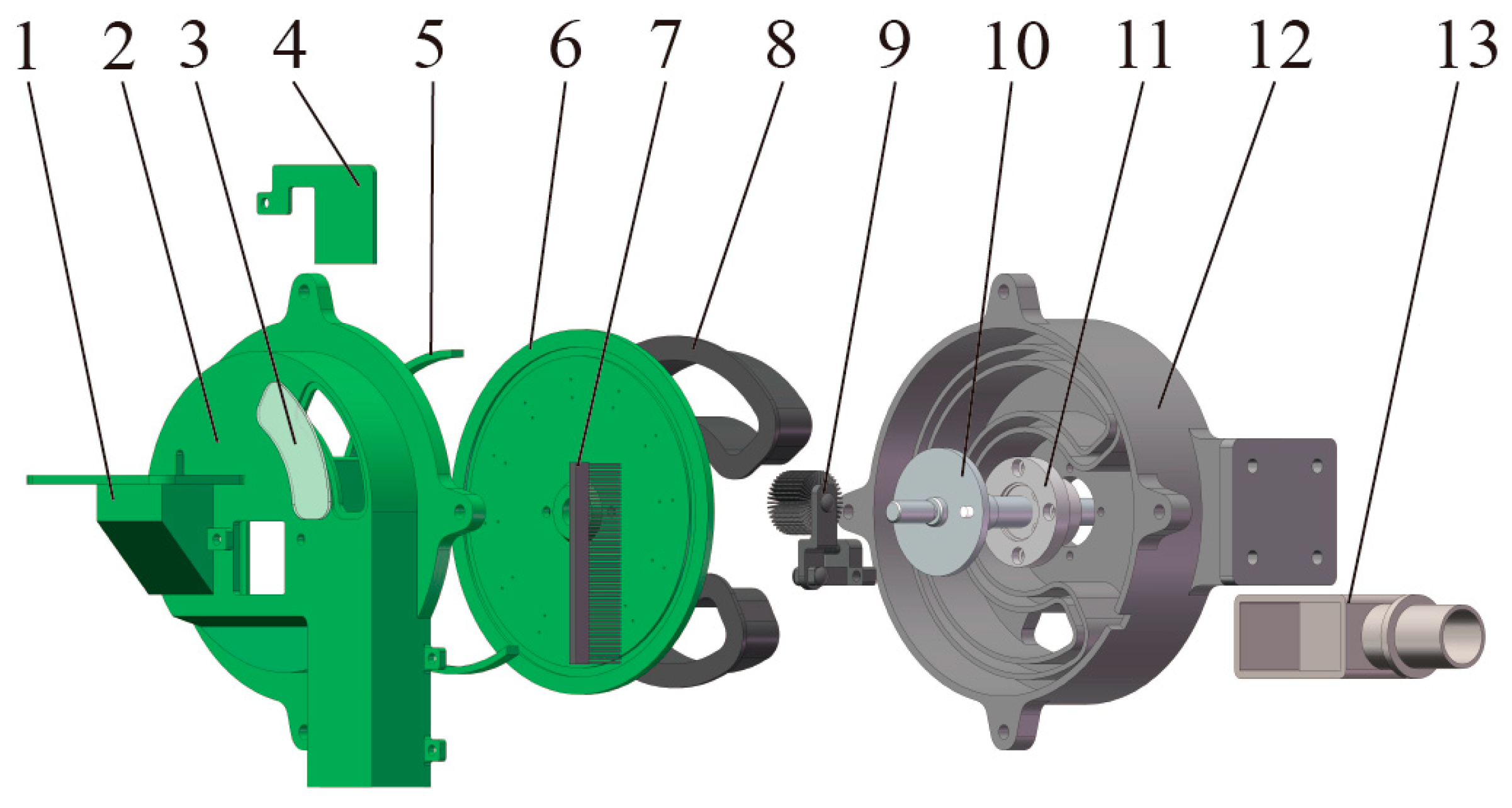
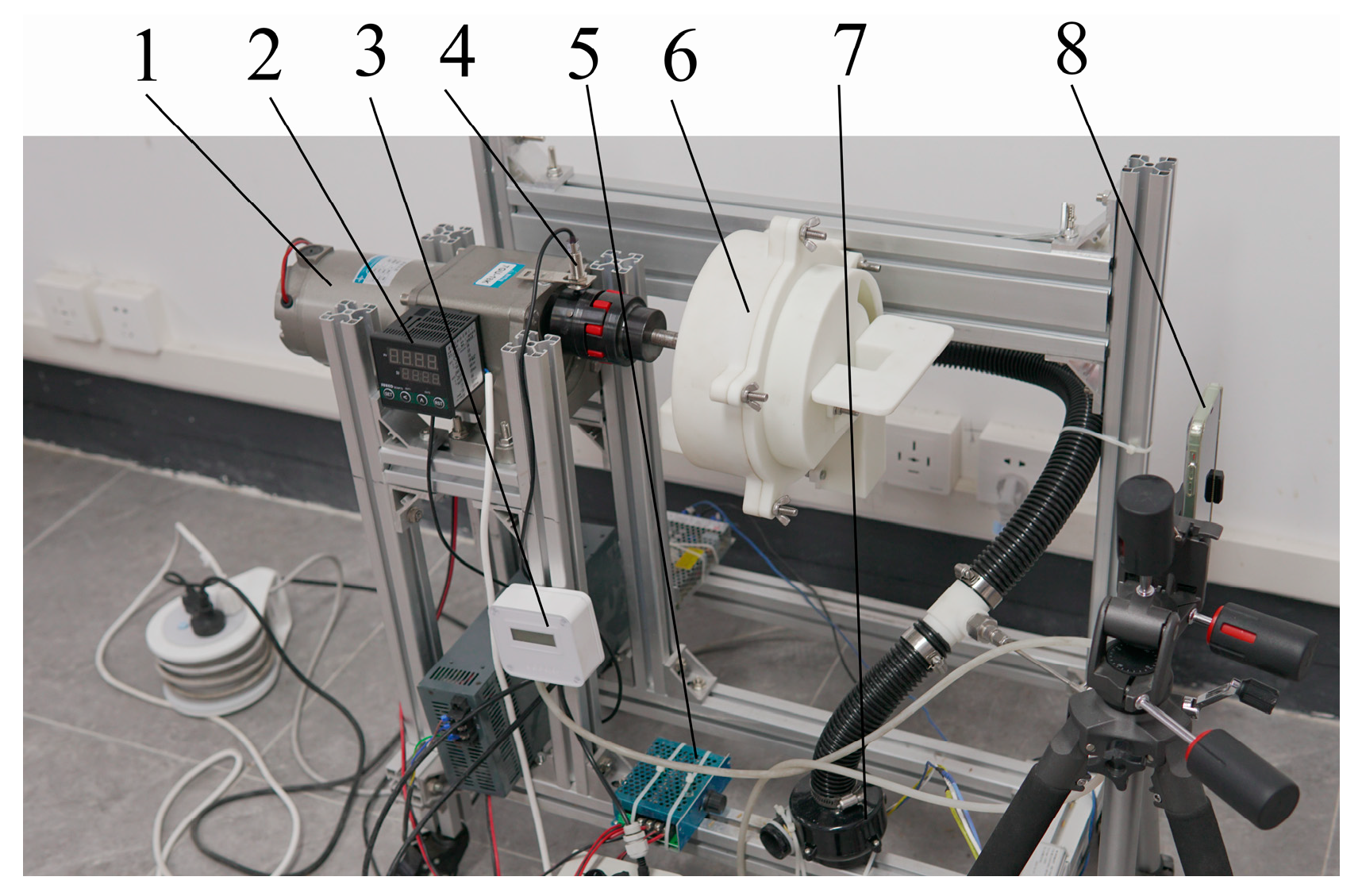
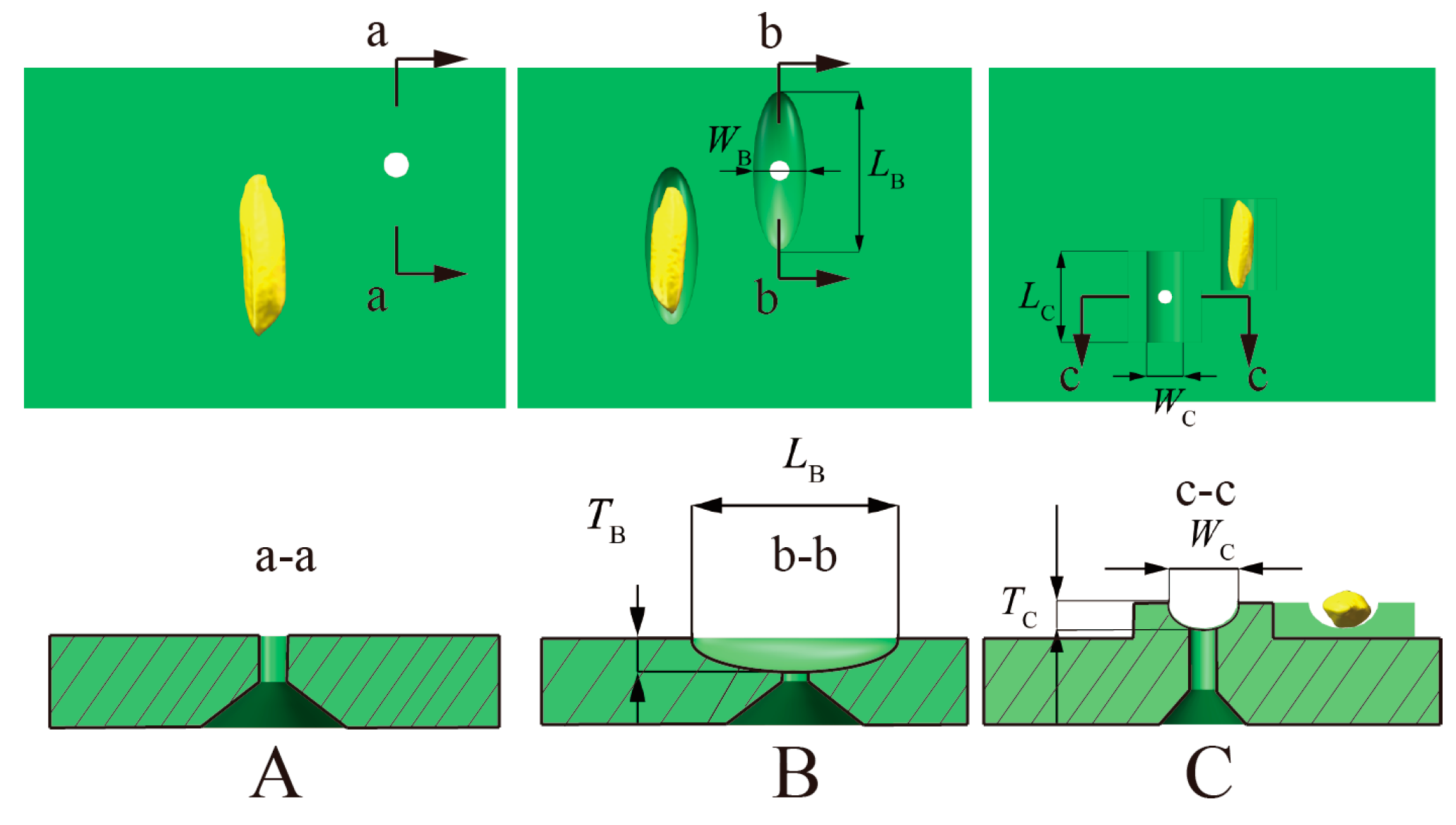



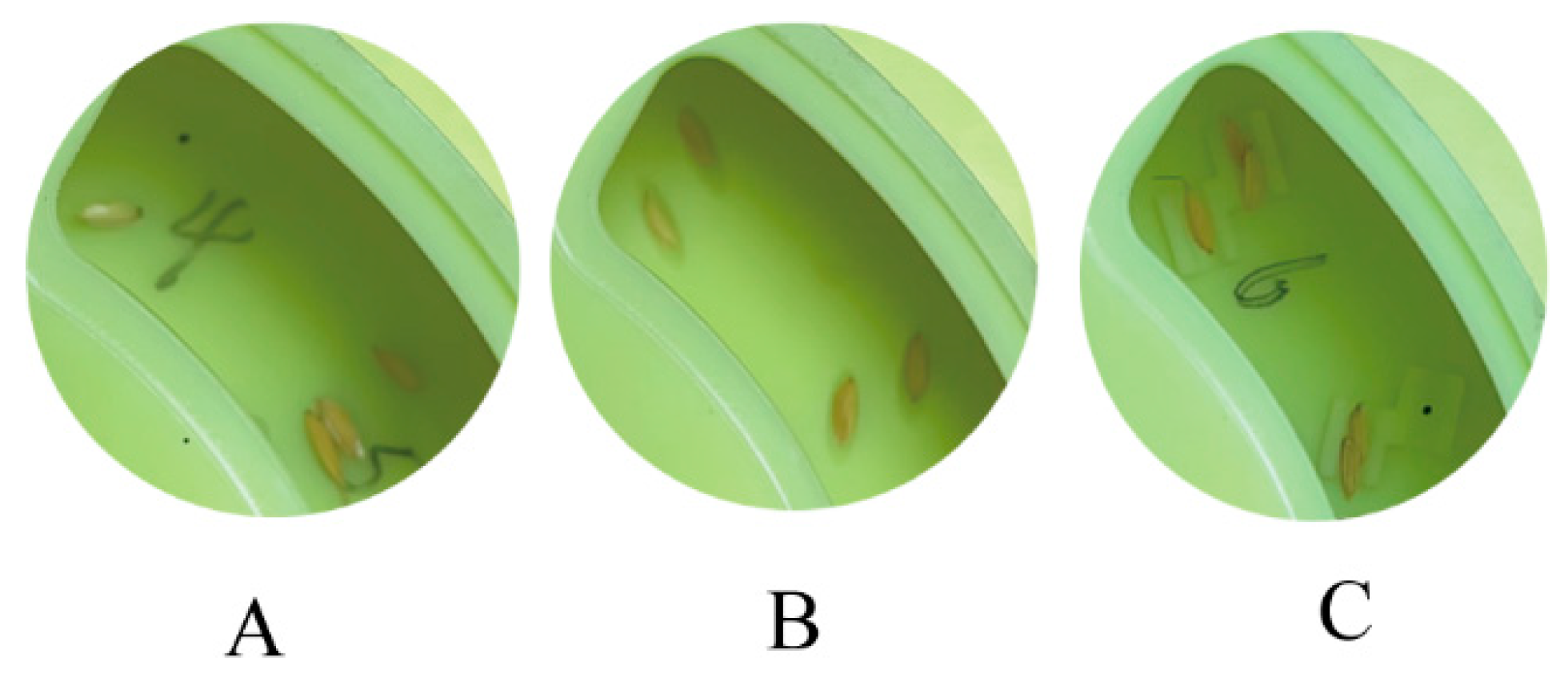
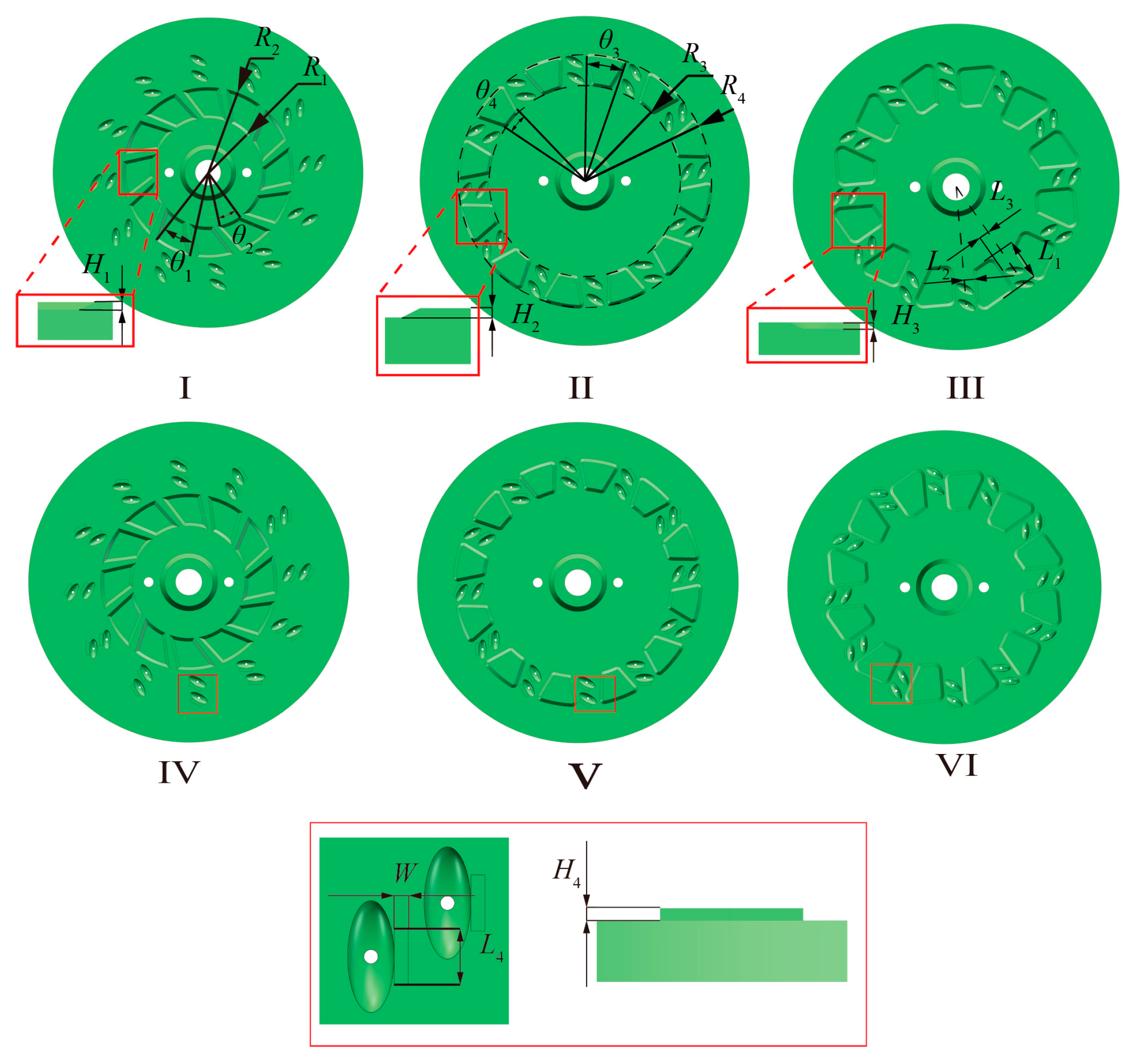

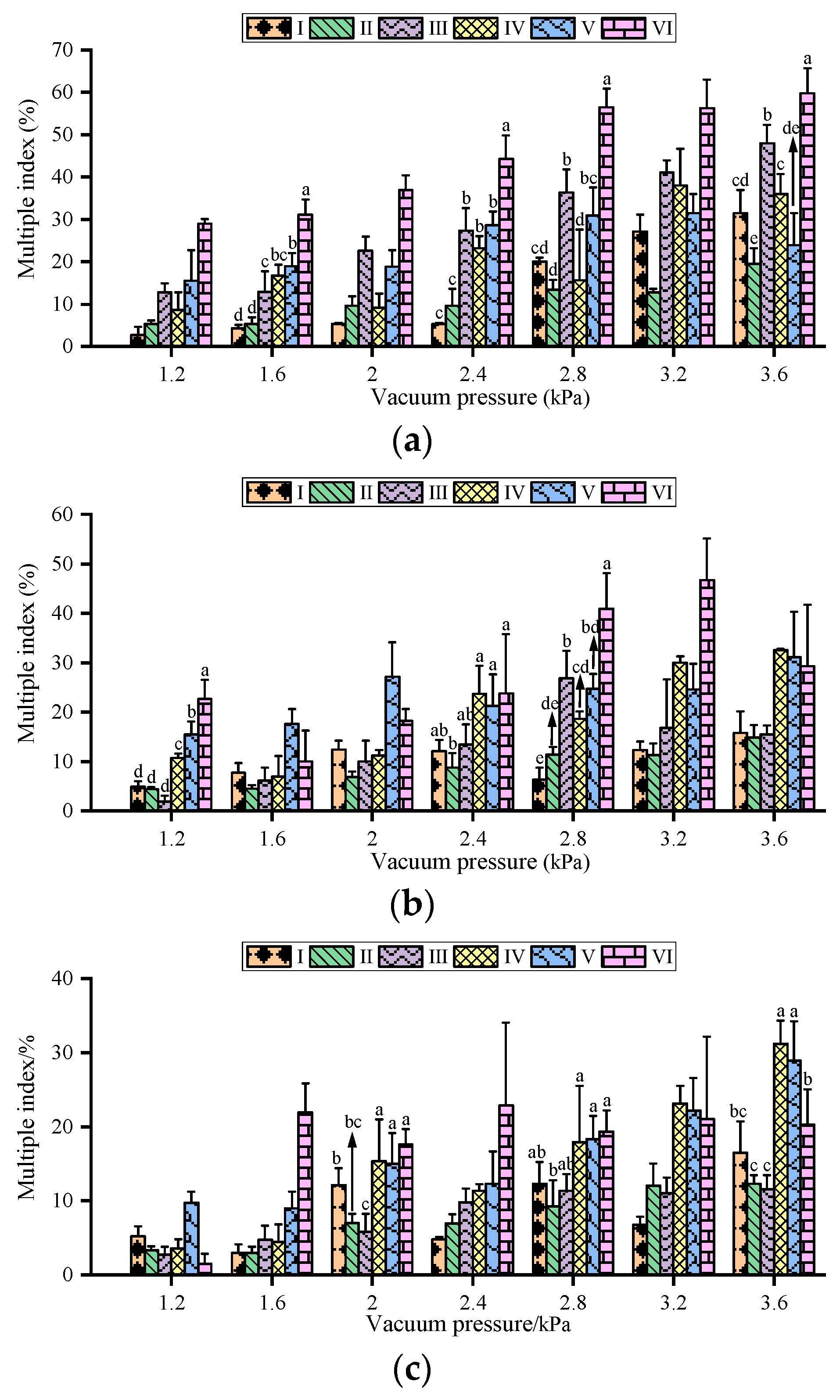
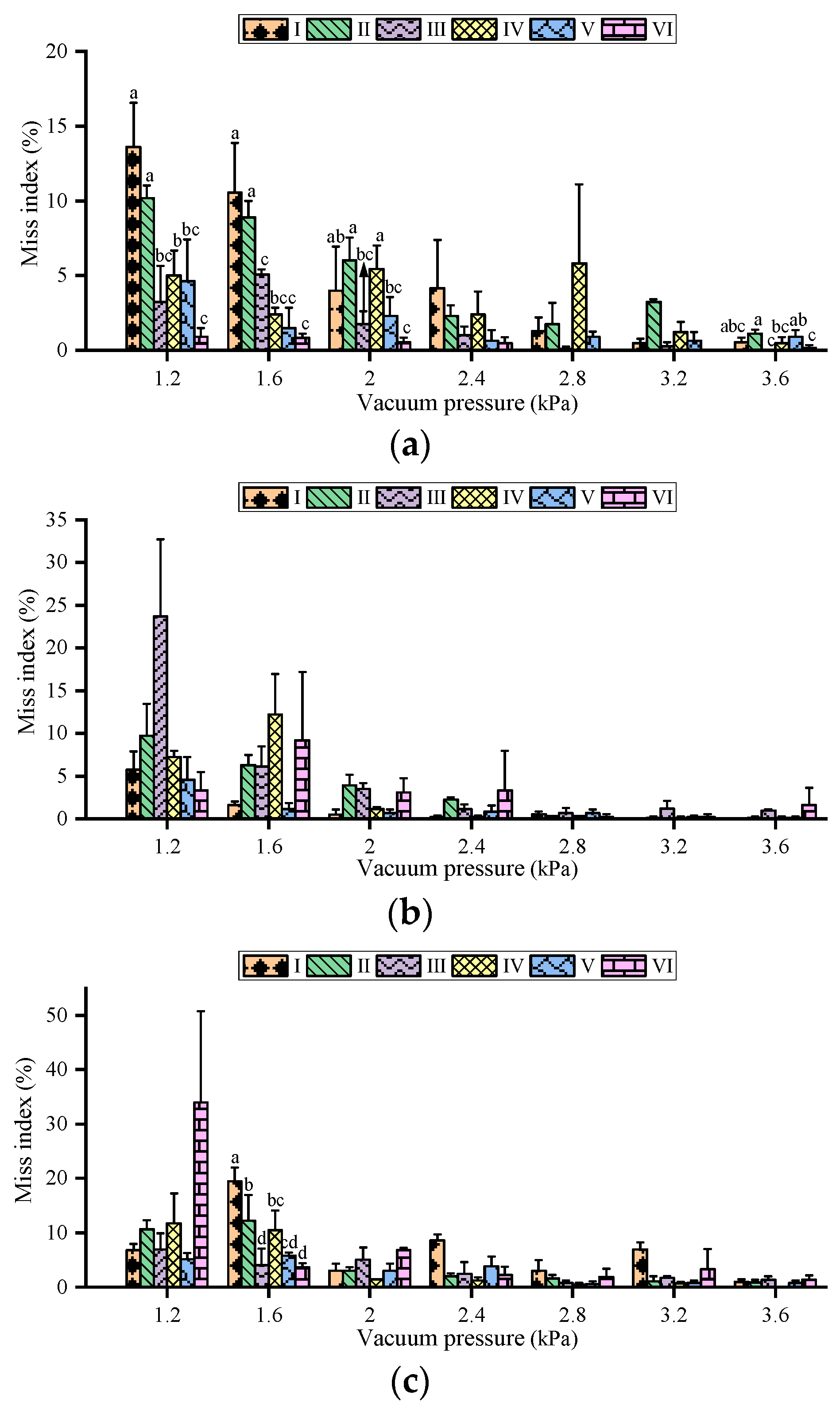
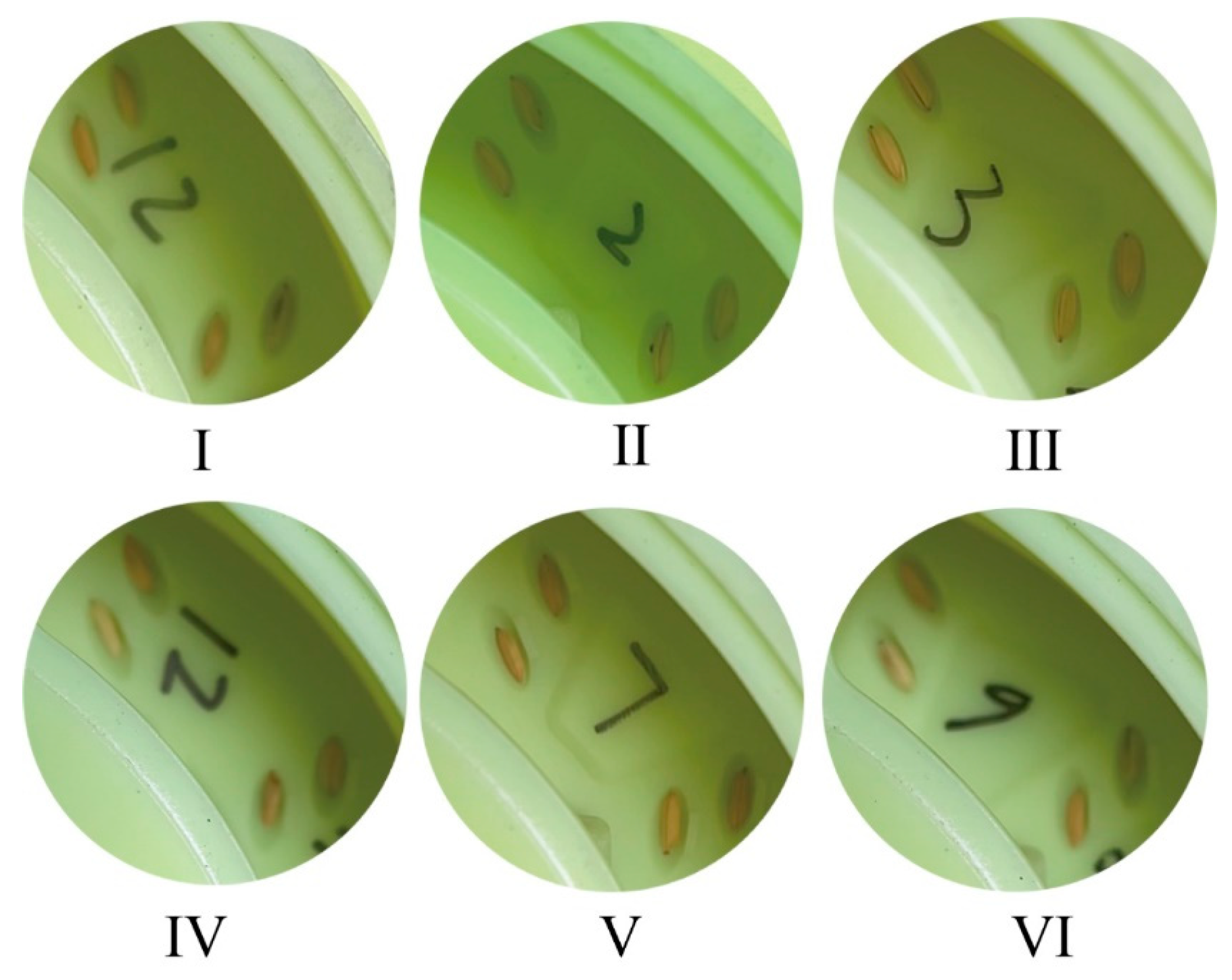

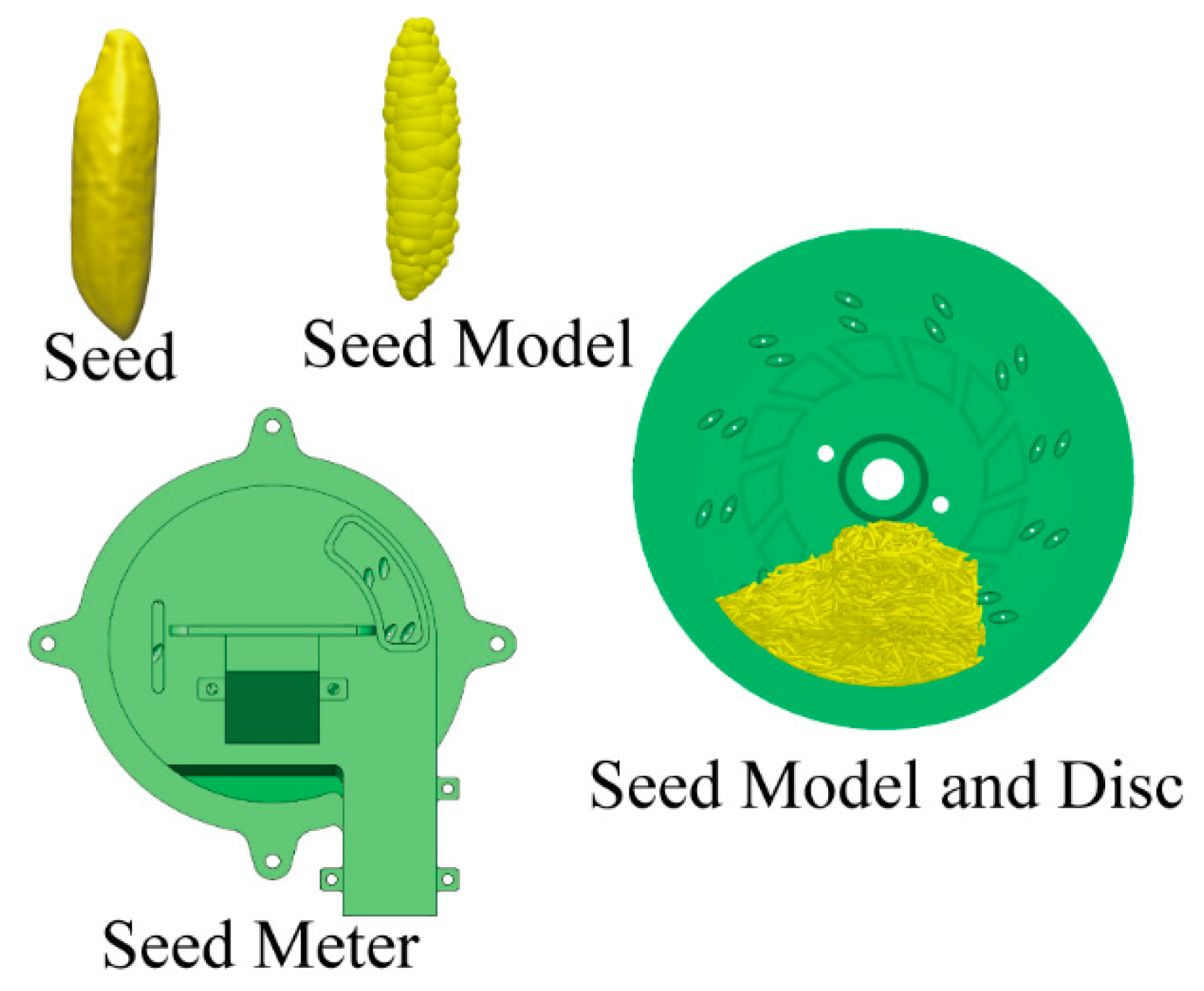
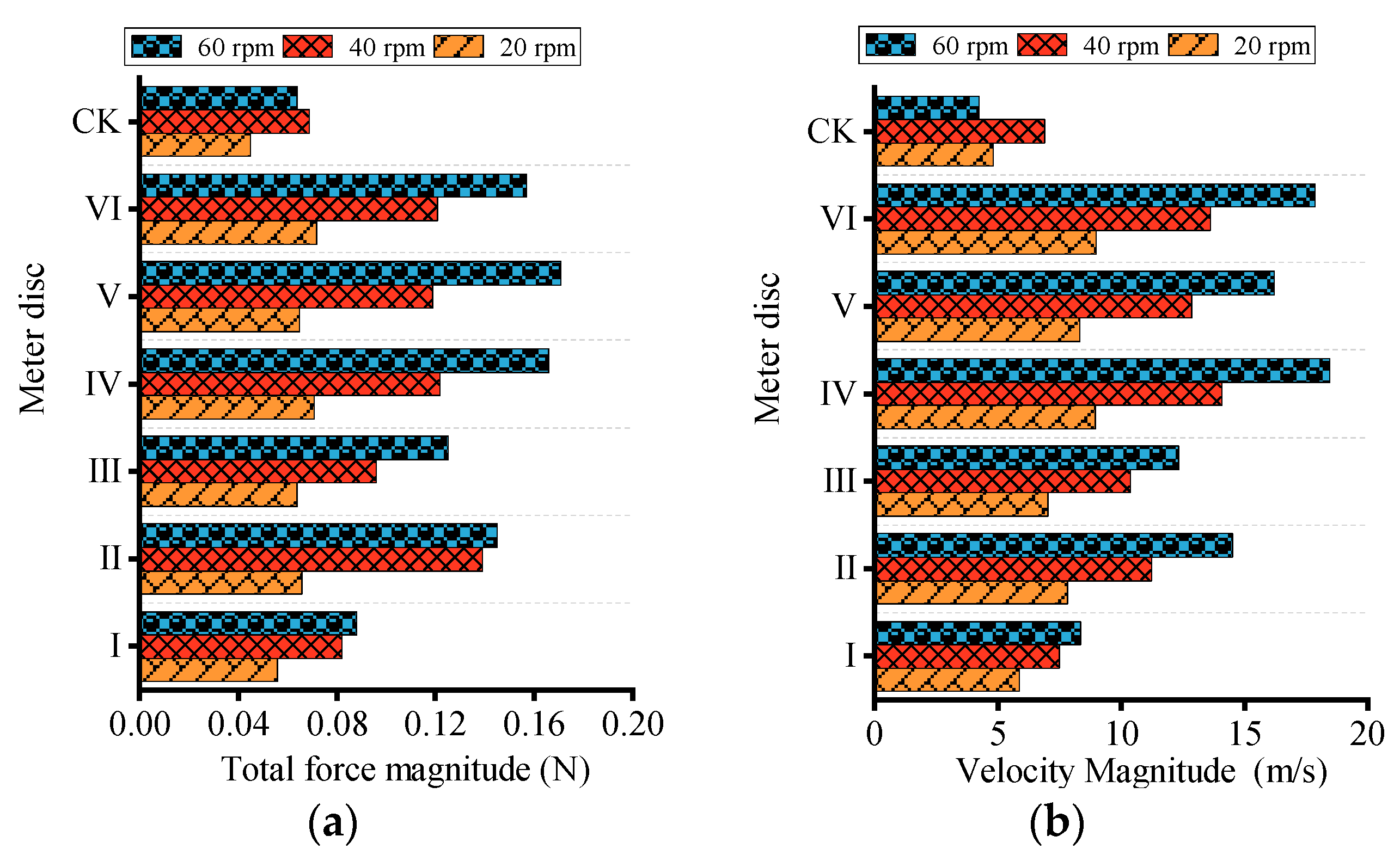
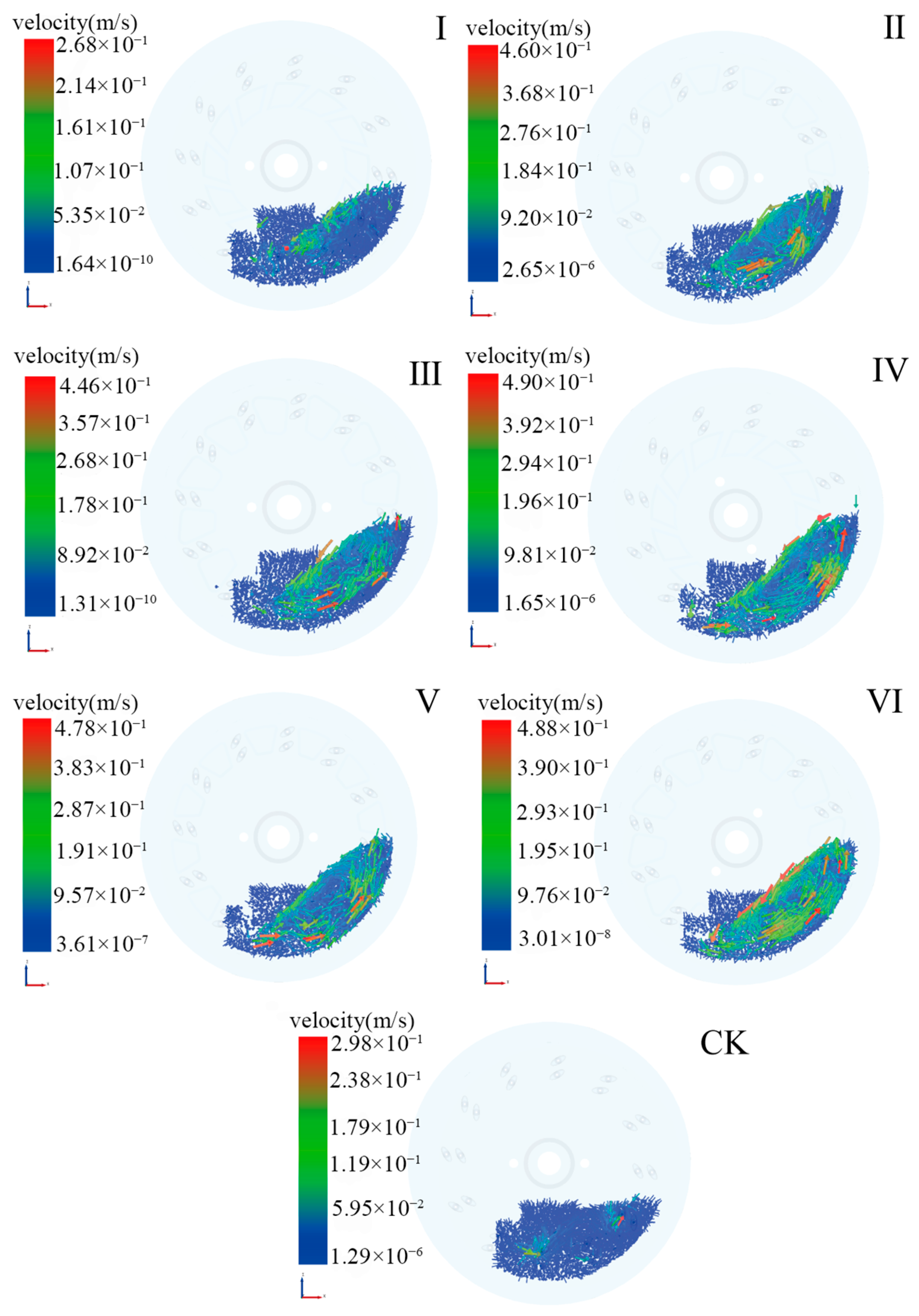
| Model | VIF | Coefficient | SD | Significance | |||
|---|---|---|---|---|---|---|---|
| All | QFI | Multiple | QFI | Multiple | QFI | Multiple | |
| Constant | 67.51 | 22.48 | 2.63 | 2.67 | <0.01 | <0.01 | |
| Speed | 1.00 | 0.24 | −0.29 | 0.04 | 0.04 | ||
| Vacuum | 1.00 | −4.45 | 7.93 | 0.72 | 0.73 | ||
| SDS I | 1.67 | 18.42 | −19.13 | 1.99 | 2.02 | ||
| SDS II | 1.67 | 20.39 | −20.89 | 1.99 | 2.02 | ||
| SDS III | 1.67 | 13.69 | −13.40 | 1.99 | 2.02 | ||
| SDS IV | 1.67 | 11.83 | −11.50 | 1.99 | 2.02 | ||
| SDS V | 1.67 | 10.56 | −8.78 | 1.99 | 2.02 | ||
| Model | Sum of Squares | df | F | p | R2 | |
|---|---|---|---|---|---|---|
| QFI | Regression | 8947.4 | 7 | 30.74 | <0.01 | 0.65 |
| Residual | 4906.37 | 118 | ||||
| Multiple | Regression | 13,853.68 | 7 | 46.27 | <0.01 | 0.73 |
| Residual | 5046.82 | 118 | ||||
Disclaimer/Publisher’s Note: The statements, opinions and data contained in all publications are solely those of the individual author(s) and contributor(s) and not of MDPI and/or the editor(s). MDPI and/or the editor(s) disclaim responsibility for any injury to people or property resulting from any ideas, methods, instructions or products referred to in the content. |
© 2024 by the authors. Licensee MDPI, Basel, Switzerland. This article is an open access article distributed under the terms and conditions of the Creative Commons Attribution (CC BY) license (https://creativecommons.org/licenses/by/4.0/).
Share and Cite
Qian, C.; He, S.; Qin, W.; Jiang, Y.; Huang, Z.; Zhang, M.; Zhang, M.; Yang, W.; Zang, Y. Influence of Shaped Hole and Seed Disturbance on the Precision of Bunch Planting with the Double-Hole Rice Vacuum Seed Meter. Agronomy 2024, 14, 768. https://doi.org/10.3390/agronomy14040768
Qian C, He S, Qin W, Jiang Y, Huang Z, Zhang M, Zhang M, Yang W, Zang Y. Influence of Shaped Hole and Seed Disturbance on the Precision of Bunch Planting with the Double-Hole Rice Vacuum Seed Meter. Agronomy. 2024; 14(4):768. https://doi.org/10.3390/agronomy14040768
Chicago/Turabian StyleQian, Cheng, Siyu He, Wei Qin, Youcong Jiang, Zishun Huang, Meilin Zhang, Minghua Zhang, Wenwu Yang, and Ying Zang. 2024. "Influence of Shaped Hole and Seed Disturbance on the Precision of Bunch Planting with the Double-Hole Rice Vacuum Seed Meter" Agronomy 14, no. 4: 768. https://doi.org/10.3390/agronomy14040768
APA StyleQian, C., He, S., Qin, W., Jiang, Y., Huang, Z., Zhang, M., Zhang, M., Yang, W., & Zang, Y. (2024). Influence of Shaped Hole and Seed Disturbance on the Precision of Bunch Planting with the Double-Hole Rice Vacuum Seed Meter. Agronomy, 14(4), 768. https://doi.org/10.3390/agronomy14040768






